Evil Genius 2 updates the best parts of the cult classic villainy sim
No, dear reader. I expect you to die.
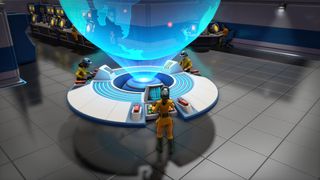
Evil Genius 2 is a direct sequel to the cult classic 2004 lair builder of over-the-top spy-fi comedy and action. The original was a strategy management unlike any other, and the team at Rebellion knows that. This sequel is more lavishly made, with a more '60s retro flair than the first, but it retains and updates the best parts.

Best PC games: All-time favorites
Best free PC games: Freebie fest
Sims 4 cheats: Life hacks
GTA 5 cheats: Phone it in
GTA 6: Grand theft next
2021 games: This year's launches
I watched a live gameplay demo and spoke with two members of the EG2 team: producer Ash Tregay and lead designer Rich Edwards. Edwards is an EG superfan, so this is his dream design. He's so enthusiastic that when interviewed for the then-secret project he puzzled out what Rebellion was doing and asked point blank, mid interview, if it was Evil Genius 2.
In Evil Genius 2 you dig into the nitty-gritty details in the life of an over-the-top spy fiction villain. You build up your base and casino resort cover operation on a tropical island, gathering an army of minions and building infrastructure for your Doomsday Device. None of this is cheap, and that means stealing a lot of gold. You manage strategy on a world map to accomplish missions, building a worldwide criminal network. You also need armed thugs, media spin doctors, and deadly traps to keep the Agents and Superspies of the Forces of Justice off your back.
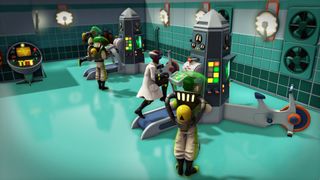
To start you'll pick one of four evil geniuses and one of three islands. "The island you choose is your home for the entire campaign," says Tregay. One island has already been shown—the medium option. Another is tall and narrow, with more vertical space. On that island visitors arrive by cruise ship, then take cable cars up to the casino, giving you a bit more time to react to new arrivals. The third island is squat and round, with a helipad in the middle, like a donut.
Each of the geniuses has their own style: unique campaign missions, specialities, and Doomsday Device. Maximilian is the industrial tycoon of EG1, obsessed with making money. Red Ivan was a mere henchman in EG1, but he's a boss now. The other two are newcomers we don't know much about, "Emma is a Spymaster turned Anarchist with a heavy deception focus, whilst Zalika leans into science," says Edwards.
But we've left the Evil Genius world for 16 years, so Edwards describes the story, "We're following a timeline where the Evil Genius conquered the world, ruled it with an iron fist for some time, and then—because these characters are always attracted to the struggle and the underdog approach—they've backed off, and now vanished, leaving a power vacuum."

Red Ivan has been through it. He's lost a hand and gained a metal one, but he still likes explosions and carries a rocket launcher to deal with enemies. "At the start of the campaign he's a deposed warlord," says Edwards, "His country of Ivannia has fallen and he is attempting to rescue people from there."
The biggest gaming news, reviews and hardware deals
Keep up to date with the most important stories and the best deals, as picked by the PC Gamer team.
It's a lot more story than EG1 had. "We put a much stronger focus on the narrative," says Edwards. "We want to make sure we are following the genius from the inception, and all of the challenges you would have to overcome."
The centrepiece of the campaigns, and of your lair, is the Doomsday Device. Your device is built in stages, but it's not static like EG1: you get to fire it often, reaping risks and rewards on the world map. Red Ivan's is the H.A.V.O.C. device, an unsubtle and roaring red-coated dynamo of a cannon that causes widespread devastation. Ivan's forces then capitalise on the chaos to further his schemes. There's no subtle use for Ivan's, but Maximilian's Midas Device transmutes solid objects to gold—like entire buildings. Max's minions can then go steal the target for some extra income.
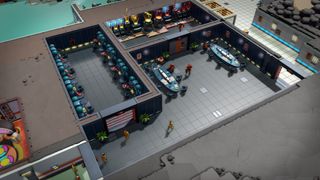
As the Doomsday Device progresses, so do a genius's abilities. One of Edwards' favourite examples is Maximilian. At first, Max uses a regular pistol to execute disloyal henchmen or enemies. Later he perfects his Midas Pistol, which turns unfortunates into solid gold statues.
The centrepiece of the campaigns is the Doomsday Device: you get to fire it often, reaping risks and rewards on the world map.
Each Genius's campaign will take 12-16 hours to complete, but that's without doing any side stories. "We've made sure that there's a heap of optional content," says Edwards. Optional missions are how you recruit Henchmen, the Oddjobs to your Goldfinger. They start on the world map as rival crime lords, and only by besting them can you win them to your cause. One returning henchman is Jubei, the master swordsman, now well into old age and hobbling about with a staff.
With all this new stuff, Edwards emphasises that EG2 is flexible—you can now pause and fast-forward play. "[EG2] moves at the pace you're comfortable with. If you do want to spend your time just crafting your perfect lair, you can do that."
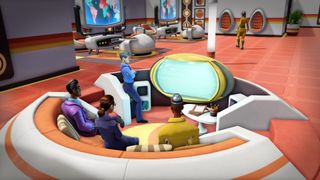
There'll be a lot to craft. All 15 room types from EG1 make a return, but with expanded functions. "So, whilst we have the Infirmary back," says Edwards, "it is also a room you can use to push your minion stats higher than they ever would have been." Continuity was key to Rebellion's process, and they made sure that fans would feel right at home by watching EG1 Let's Plays and studying bases on player-made planning tools.
Tregay explains their production philosophy, "Taking what the original did well forward and then augmenting and building on that as a foundation," he says. A key feature Edwards preserved from EG1 was combining rooms. "So in a single area you might have a Barracks with a Mess Hall in the middle and some weapon racks on the side walls," says Tregay, "to really build the lair however you desire, and you'll find that those options open up as you become more familiar."
Evil Genius 2 looks smooth and responsive in motion, and it really feels like you're playing a character whose every whim is feared. The interface is more up to 2020 standards, as is unit AI. Minions snap to, and are quick to carry out orders like construction, training and placement. Rooms have new doodads like benches, trophy cases, and potted plants, which have effects like helping minions recover spent stats faster.

Series fan Edwards was excited to simplify the elaborate, deadly traps, "If you put down traps in your lair, and you put them down close together and point them at each other, they just automatically network, straight out of the box." So if you put down a wet bar of soap between a jet-engine fan and a shark tank, for example, the fan knows to start blowing after an enemy Agent slips on the soap.
Easy as it is to design rooms, it's simple to redesign. Rebellion wants you to reconsider base layout throughout the campaign. "Simple lairs with just a small barracks and a small set of defences grow into these multi-floor spanning things with hundreds of minions walking around," says Edwards, "That process takes quite a while for the player to go through, and at every stage they have to make sure that everything is working smoothly."
But it's not all lairs and no spies, so Agents of the Forces of Justice are smarter. That was a major focus of production for Tregay, "The Forces of Justice agents are a perennial threat in Evil Genius 2. They're going to be showing up with the same frequency as tourists in your cover operation. They'll be blending in amongst them, coming off the same cruise ships to begin with, and making their way through to the lair itself."
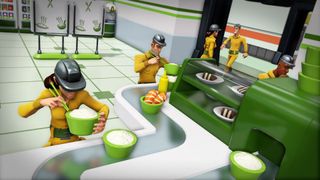
Agents have finally figured out disguises. You might catch someone wandering about in a minion jumpsuit… with a bomb strapped to their back. You then tag them for real minions to deal with. You can also set responses in advance using automation tools, telling minions to escort unwanted guests out of low-sensitivity areas or kill on sight.
As time wound up I had to ask about the best feature from EG1: cloning. You could make and sacrifice clones to fake your own death. Will it be in? "Not going to answer that," Edwards laughed. I insist that if it's a sequel, then clones are canonical. "It is absolutely canonical," says Edwards, "but we've made sure that its application is a lot more evil than it used to be." We'll find out more when Evil Genius 2 releases in early 2021.
Jon Bolding is a games writer and critic with an extensive background in strategy games. When he's not on his PC, he can be found playing every tabletop game under the sun.
Most Popular


